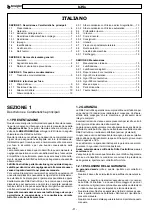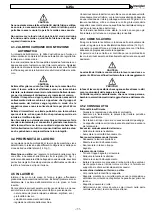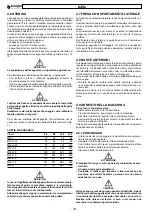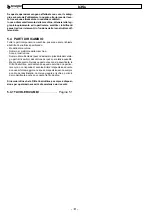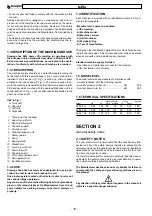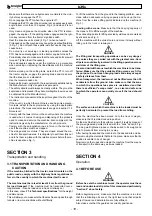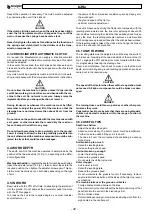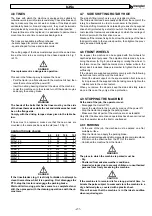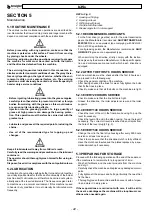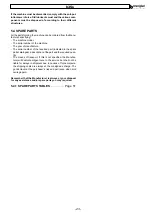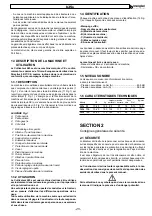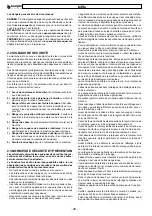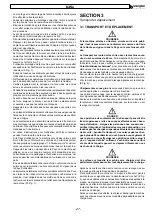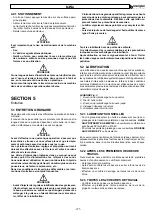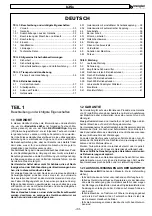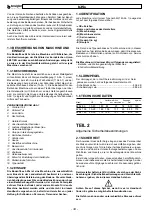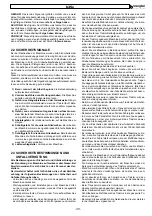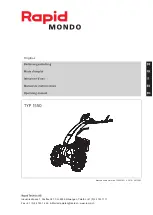
- 20 -
b25s
Repeat the operation if necessary. The clutch must be adjusted
by unscrewing the nuts if it is blocked.
CAUTION
If the clutch still slips even when all the nuts have been tight-
ened, the friction plates must be changed as they could be
worn or because the springs have become slack.
Never fully tighten the nuts as this eliminates the function of
the springs and clutch itself, to the detriment of the trans-
mission components.
4.3.2 DRIVELINE WITH AUTOMATIC CLUTCH
On request, the Manufacturer can supply a driveline complete
with automatic clutch calibrated for a medium-duty load. This clutch
cannot be adjusted.
In the event of an overload, the clutch slips and continues to oper-
ate as soon as the obstruction has been passed, without external
intervention.
Any clutch servicing operations must be carried out in the work-
shop in compliance with the driveline manufacturer’s instructions.
CAUTION
Do not allow the machine to operate unless it digs into the
soil. When working, do not drive around bends with the ma-
chine in the soil. Do not work in reverse. Always raise the
implement before you change direction or reverse.
During transport or whenever the machine must be lifted,
remember to adjust the power lift of the tractor so that the
steerage hoe is not raised more than about 40 cm from the
ground.
Do not drive on the public roads with the machine caked with
soil, grass or other materials that could dirty the road sur-
face or hamper the traffic in any way.
Do not allow the machine to drop violently on to the ground.
Lower it slowly to allow the tines to gradually penetrate into
the soil otherwise all the machine components would be sub-
jected to stress that could lead to breakages.
4.4 WORK DEPTH
The depth at which the machine operates is determined by the
position of the two side skids (14 Fig. 1), depending on the differ-
ent configurations.
Machine with skids: to regulate the depth for machines with skids,
loosen the adjuster screw (15 Fig. 1), raise or lower the skid to the
required position, then tighten the adjuster screw again. This op-
eration must be carried out on both skids depending on the type
of soil.
4.5 IN WORK
Begin work with the PTO at full rate. Gradually dig the implement
into the ground. Do not depress the accelerator pedal too much
with the PTO engaged.
To break up the soil to the required degree, you must consider
several factors, i.e.:
- the nature of the soil (medium consistency, sandy, clayey, etc.)
- the work depth
- the ground speed of the tractor
- optimum machine adjustment.
The soil is broken up by driving the tractor at a low speed, with the
levelling plate lowered and the tine rotor spinning at about 200
rpm. besides containing the clods that have already been broken
up by the tines, the levelling plate also achieves a well levelled
and homogeneous ground surface after the soil has been worked.
If the levelling plate is raised, the clods will not longer be broken
up and the soil will not be levelled.
4.5.1 HOW TO WORK
The levelling plate must be adjusted to suit the way the soil is to
be broken up. Now adjust the two side skids of the machine (14
Fig. 1), engage the PTO and begin to move forward with the trac-
tor, progressively lowering the steerage hoe.
Cover a short distance, then check to make sure that the work
depth, soil crumbling and ground levelling operations have been
carried out in the required way.
CAUTION
The speed of the tractor when the machine is operation must
not exceed 6-8 kph or components could be broken or dam-
aged.
DANGER
The turning tines could throw up stones or other sharp ma-
terials as they work.
Constantly check to make sure that there are no bystanders,
children or domestic animals within the range of action of
the machine.
4.5.2 USEFUL TIPS
Depth too shallow
- Adjust the depth skids again.
- Advance more slowly. The tractor power could be insufficient.
- Further runs are needed if the soil is too hard.
- The tines roll over the soil instead of penetrating it: advance
more slowly.
Soil broken up too much
- Raise the levelling blade.
- Increase the ground speed.
Soil not broken up enough
- Lower the levelling plate.
- Reduce the ground speed.
- Do not work in soil that is too wet.
Rotor clogged
- Soil too wet to work.
- Raise the levelling plate.
- Reduce the ground speed.
- Do not work where the grass is too tall. If necessary, remove
any material that has built up at the sides of the rotor to prevent
overheating.
The machine jolts over the ground or vibrates
- Foreign bodies blocked between the tines.
- Tines incorrectly mounted without the helical positioning or that
penetrate into the soil with the blunt edge first.
- Worn or broken tines.
- Rotor misshapen owing to blows received during work from for-
eign bodies in the central part.
Summary of Contents for ZAPPATRICE b25s
Page 4: ... 4 b25s Fig 3 Fig 5 Fig 4 A B 1 3 MAX MIN 4 cm 6 7 4 1 2 8 5 3 ...
Page 5: ...b25s 5 1 2 3 4 5 A Fig 8 Fig 7 Fig 6 ...
Page 53: ...b25s 53 Tav 2 Z0100206 0015122 8040306 ...
Page 54: ... 54 b25s Tav 3 GRUPPO SCATOLA COMPLETO 0500514 ...
Page 55: ...b25s 55 Tav 4 Configurazione CadMEC Configurazione CadMEC Z2500002 ...
Page 56: ... 56 b25s Tav 5 8064820 ...
Page 57: ...b25s 57 Tav 6 8065035 0014106 ...
Page 58: ...b25s 58 Tav 7 cod 8064658 0121237 0030242 ...
Page 59: ... 59 b25s Tav 8 cod 8064664 0121237 0121237 ...
Page 60: ...b25s 6 0 NOTE ...
Page 61: ...b25s 61 NOTE ...
Page 62: ... 62 b25s NOTE ...
Page 63: ...b25s 63 NOTE ...

